Journal
About Andrew Cusack
 Writer, web designer, etc.; born in New York; educated in Argentina, Scotland, and South Africa; now based in London.
Writer, web designer, etc.; born in New York; educated in Argentina, Scotland, and South Africa; now based in London. read more
News
Blogs
Reviews & Periodicals
Arts & Design
World
France
Mitteleuropa
Knickerbockers
Argentina
The Levant
Africa
Cape of Good Hope
Netherlands
Scandinavia
Québec
India
Muscovy
Germany
Academica
Our Walter, Rest in Peace
I was very saddened to hear this morning of the sudden death of our good and loyal friend, Walter Phelan of Brooklyn. Walter was a good man, with a heart of gold, and a brilliant mind. He taught himself the law, and passed the New York bar exams in the years before at least a year in law school was required (a development which Walter would’ve been the first to tell you was an outright racket). I have no doubt that Walter will be remembered for his numerous small kindnesses. Proud of his favorite Italian bakery, he would hand out loaves of bread from there every Sunday on the sidewalk outside St. Agnes after the 11:00 Tridentine mass. Having a gift for languages, he would often exchange a few kind words with the Polish waitress in her native tongue whenever we had lunch at Bloom’s on Lexington, and he made sure to tutor his young nephew in Latin when he discovered it wasn’t offered at school.
One of the things I liked most about Walter is that he was never afraid to have a good argument. More often than not, he and I found ourselves in agreement, but it was sometimes otherwise, such as with his firm contention that Shakespeare’s plays were actually written by the Earl of Oxford. Nonetheless, he was polite and gracious in dispute, even if outspoken. Still, he was a private man, and as a friend said of him tonight, it would probably take five of his friends who’d never known eachother to piece together the story of his life. Walter heard mass three times a day, and could often be found attending masses at St. Agnes on 43rd Street, at St. Vincent de Paul’s on 24th, and at St. George’s Ukrainian Catholic Church down on 7th Street. Earnest in his desire for the salvation of souls and their eternal repose, he never missed the monthly mass of the New York Purgatorial Society. His friends will miss him very much.
Requiem æternam dona eis, Domine, et lux perpetua luceat eis.
Requiescat in pace. Amen.
A Morning’s Journey
I crossed the Harlem River into Manhattan today just as Patrick Leigh Fermor traversed the Danube in his brilliant book, A Time of Gifts, which has immediately become one of my favorite reads of all time. Settling into my seat on the train yesterday, I opened my knapsack to utter shock and surprise—I had left my reading at home. The Leigh Fermor and P.G.W.’s Cocktail Time were resting somewhere in my bedchamber while I stared into the compartment of my bag, bare but for a photocopied page from the Art Newspaper and two (already-read) issues of the Hungarian Quarterly. These are the times that try men’s souls. Getting out of the city late in the evening proved even harder, as the bridge carrying the railway over the river was actually up for once (“First time in my life, folks,” the conductor informed us), leaving a steady backlog of trains awaiting their northerly destinations.
But this morning there were no bridge-raising complications, and the sky was a delightful, clear blue (soon to change) as we entered Manhattan. Thankfully, I had my two books; a bit of Wodehouse while waiting in Bronxville station and then Paddy Leigh Fermor on the train. After crossing the river, the train stops at 125th Street (Harlem) before submerging at 96th, taking the passenger down to Grand Central, that well-kept remnant on 42nd Street, reminding us that we too were once civilized. There, after taking a stroll through the market (Nürnburger sausage! Kaiser ham! Norwegian salmon!) you switch to the subway and hop down just one express stop on the 5 train.
Just half a dozen steps after emerging from Union Square station I saw a speck of white fall from the sky, and then another, and another. So it began: the first snowfall of the year. And, I might add, a New York record for the latest snowfall. (January 10th? No, there was no white Christmas for us this year). Two children on the swings in the playground ecstatically proclaimed their approval at the opening of the heavens. Wandering through the farmer’s market in the square, I picked up an herb focaccia bread I thought might be particularly enjoyable, and it complimented the exceptionally tasty Tuscan vegetable soup I had for lunch. The snowflakes swirled above the square and fell down on all the market-goers and the folks walking on Broadway as I marched up to work. And yet, how fleeting! In the few steps from the front door to the elevator, the white snow had already melted and merged into the green of my loden coat. Very well, Mother Nature. Very well.
A New Year
A splendid New Year’s Eve. We watched Mrs. Miniver before retiring to the living room, where I made a fire. We sat before the open flame for two hours, first with a generous helping of port then followed by a good old bottle of Veuve, with naught but a few candles, the lights of the Christmas tree, and the crackling fire to illuminate the room. It was all quite lovely.
We remembered a number of the things which had come to pass in the last year, and after we had opened the champagne (the dog grabbed the cork and was happily chewing on it beneath the dining room table) we made a few toasts. To the Queen, to the Duke of Edinburgh, to dear old Aunt Kay who passed away this year. Aunt Kay lived in numerous interesting places in the post-war period, from Nigeria where they had to deal with snakes on the verandah (or was it monkeys?) to Madrid in Spain to London where they lived in Princes Gate, right on Hyde Park. They were parishioners at the Oratory, which is why it is the first church in Britain in which I ever heard Mass (the summer after kindergarten). They had returned to the States a good number of years ago and she passed on just a few weeks ago at a ripe old age. To Gerald Ford, our late president. Then there were toasts to little Finn, my nephew, and to other friends and relations, kith and kin. I raised a glass myself to our own Tom Grant, whom we so sadly lost this year, and hoped and prayed his mother and father were baring up well. We remembered dear Cousin Marilyn, who was greatly missed at a family gathering on Saturday, God rest her soul. I will always remember the prognostications which she delivered with absolute authority. “Wallis Simpson? A man.” “You’re joking.” “A man. When she died, they only found men’s underwear.”
Eventually, we discovered that, like the proverbial thief in the night, the hour of twelve had come and the new year was upon us. A few final swigs of champagne and then a resting of eyes before the fire was extinguished and it was time to go to bed. May God in His mercy grant us all a happy, holy, and peaceful new year.
An Evening at the Old Whitney
TO THE OLD Whitney Museum down on 8th Street, now home to the New York Studio School, which held a panel discussion to mark the twenty-fifth anniversary of the New Criterion. An interesting chat between Hilton Kramer, who left the New York Times to found the magazine in 1982, Karen Wilkin, one of our regular art critics, and James Panero, managing editor and art critic, all moderated by Michael J. Lewis of Williams College. The panel discussion covered myriad subjects related to art, from art criticism to the impossibility of an avant-garde in today’s culture of anything-goes to whether the New Criterion‘s ‘view’ of art can be considered part of any particular school of thought. Hilton had some particularly choice moments.
The building is a particularly nebulous one with many strange nooks and crannies, which can perhaps be explained by the fact that it is actually four townhouses gradually combined over a period of time. The Whitney Museum of American Art, of course, was founded in the 1930s by Gertrude Vanderbilt Whitney and was housed in these merged townhouses until moving to the specially-designed home at Madison and 75th in 1966 — widely agreed to be the ugliest building on the entire Upper East Side.
Among the nooks and crannies previously mentioned, Gertrude Vanderbilt Whitney’s former studio in the old mews building provided an excellent location for the dinner held afterwards, to which the participants, organizers, and a number of hangers-on (including yours truly) were invited. I sat between Gabbe, the New Criterion‘s former Editorial Assistant now working for the Studio School, and Joseph, an art student from outside Canterbury in Kent whose grandmother and grandfather both taught at the Studio School. Joseph and I discussed the beauty of the Somerset countryside, and I confessed I’d buy a cottage and move there in a second were it possible. The inimitable David Yezzi sat across the table and guided much of the conversation on our leg of the three tables, which had been arranged in a U-formation. A little later, I chatted with the artist seated to Gabbe’s left, who had been born in Latvia, with childhood spent in Baghdad, Italy, and England, before settling down in New York at the age of seven. We discussed the glories of Eastern Europe and the linguistic intricacies thereof. During dessert, however, I got on to architecture with the amiable Michael J. Lewis. I sung the praises of Audubon Terrace, one of my favorite spaces in all New York, which he (a Philadelphian) had only stumbled upon for the first time a month ago, and also of the nearby sculpted tomb of Bertram Grosvenor Goodhue, the greatest of all American architects.
Time waits for no man, however, and I managed to catch a late train back home from Grand Central. Alighting at Bronxville, I walked through the misty streets where the spherical streetlamps cast an eerie glow against the limestone façades of the shops. Home before midnight, and time for rest. Tommorrow, aside from being the feast of Saint Andrew, is Stefan Beck’s last day at the New Criterion. Needless to say, commemorative festivities are in order, and an alcoholic concoction known as ‘batch’ is to be brewed. It will not, I imagine, be for the faint of heart.
Elsewhere, the Austrian navy is no more.
A Book to Remember
Chumley’s Launch Party for ‘Forgotten New York’ Book
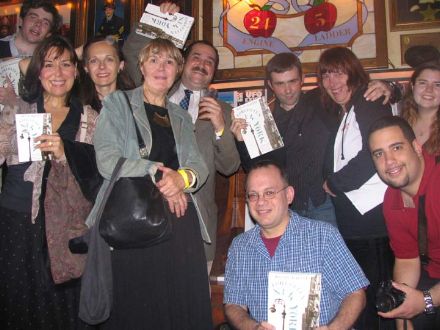
AS I GROW more and more cantankerous, my tolerance for evening trips down to Mannahatta declines, but on occasion there’s an event which would be a crime to miss. Last Thursday, Dawn Eden and I popped down to Chumley’s, the old speakeasy on Bedford Street in the West Village, for the shindig launching Kevin Walsh’s brilliant book, Forgotten New York: Views of a Lost Metropolis. (Kevin reports on the party here). I’ve been following Kevin’s Forgotten New York website for years now, and it has earned an unquestionable rank as one of my favorite sites ever (though, shamefully, I’ve never been on one of his legendary ‘Forgottentours’). The author himself was on hand, naturally, and I also enjoyed meeting a number of very kind people who are as fond of Forgotten New York as I am.
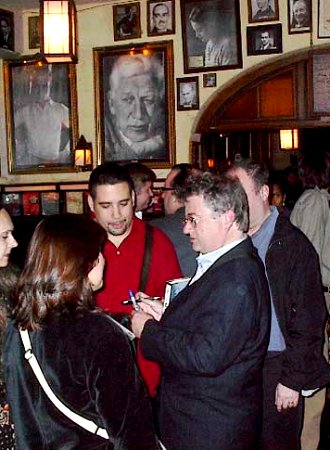
The Man of the Hour himself: Kevin Walsh (in glasses).
While Dawn and Kevin are familiar friends (she even gets a mention in the book’s acknowledgements), I had never before had the privilege of meeting this great chronicler of quinqueboronian miscellany. He is very much like his website: simple and brilliant. Happily, I got my complementary copy of the book personally inscribed, though I quite presumptuously upbraided him for only mentioning Audubon Terrace in passing (c.f. FNY: ‘I Can’t Drive 155’) while I believe it is worth a Forgotten page of its own. (Naturally, I have a post slowly developing on Audubon Terrace, which I believe is one of the most beautiful public spaces in all New York, as well as one of the most underappreciated).
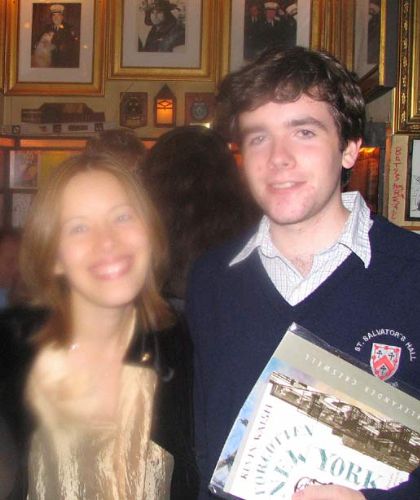
No, the camera isn’t smudged; an angelic haze follows Dawn wherever she goes.
But enough of the fun, how’s the book? Well I love it. It’s emphasis is on breadth rather than depth, since it’d be impossible to reproduce the entire contents of the encyclopedic website in a mid-sized paperback book. I view the book in two regards: first, as a handy basic guide referencing the variety of forgotten, unnoticed, and underappreciated sites around the Five Boroughs; and second, as a good jump-start companion to the more thoroughly informative website.
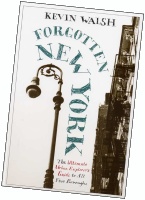
Take, for example, the Lent Riker Smith House out in Queens. Browsing through the book we see the entry on the ‘Lent Riker Smith Homestead’ which gives us two paragraphs of information. Enough to whet the appitite and plant the seed of intrigue, but when we check out the website’s entry on the house we get much, much more… and in color, to boot. I hope readers not yet familiar with the website will use the book as a springboard, but I also hope that we will be gifted with updated editions of the book in years to come, with added features.
Buy the book. Aficionados of forgotten-ny.com will appreciate a version of the familiar in dead-tree form, while the uninitiated will find it extremely useful as a foundation for appreciating Gotham’s numerous nooks and crannies. Kevin Walsh has done a great service to all those who have a love for the Big Apple.
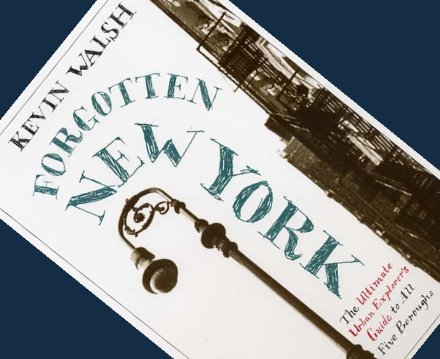
The Red Lion Coffee Shoppe
Or: How Andrew Cusack Became a Tea Drinker
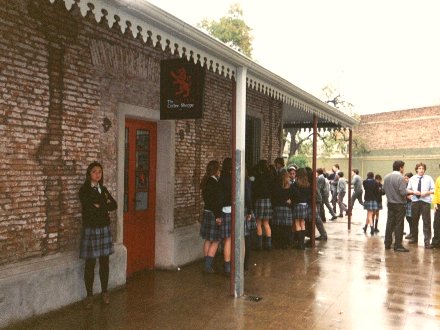
THE HOT SUMMER sun has fled us here in New York, having been replaced by the cooling but somber clouds of rain. My mind can’t help but harken back to an August of just a few years ago when I spent the summer in Argentina. Of course, New York’s summer is Buenos Aires’s winter, but in Argentina winter means prodigious rain and skies of grey, rather than the glorious snows we’re used to in the Big Apple. On the grounds of St. Alban’s College, our happy little school, there was situated the spartan but merry Red Lion Coffee Shoppe.
On many a cold, grey, Argentine August day we would escape the sufferings of education and flee to the Red Lion. There were two points of service at the Red Lion coffee shop: one a window which faced onto the outside (seen above), the other a hole-in-the wall counter which faced onto the little square room which was the shop. It was a simple, sparsely-decorated room with a few chairs and tables, the walls covered with posters lauding South African rugby and New Zealand cricket, and framed prints depicting charming views of other St Alban’s toponyms around the world: the original St. Alban’s in England, St. Alban’s in South Africa, St. Alban’s in Denmark, St. Alban’s just about everywhere. There was only one heater (the Argentines, in their desire to be in all ways like the British, do not heat their buildings properly) mounted onto the side wall opposite the counter and the obvious idea was to sit right next to the heater or else freeze. It was a black moment when one entered the Red Lion only to discover that others – the nerve! – were already situated by the heater. Rest assured, many a rueful glance was exchanged.
Anyhow, while a number of carbonated beverages were on offer, a nice warm cup of tea was much preferred to a cold, refrigerated soda. Tea at the Red Lion, which was invariably Green Hills, was accompanied by chocolate, usually fulfilled by a packet of M&M’s, but occasionally I went for Rhodesia bars which I confess I only ever bought because of their name. (Incidentally, I took a Rhodesia bar home and when I had a fetching young tutor at St Andrews who was one of the last Rhodesians to be born, I gave it to her as a gift at our last tutorial).
I had never been a regular tea drinker before then and am very glad that I acquired the happy habit; it is one which has stood me well throughout the ages. What better companion in Scotland, for example, while reading as the grey tempest of the Caledonian climate brews outside, than a nice cup of warm brew inside? And of course tea need not be a solitary joy. When I think of the hours wasted away in after-rosary cups of tea on weekday afternoons in St Andrews! It would bring scandal to some. Indeed one cold Scottish afternoon the hours of cups of tea gave way to two bottles of port, and then a raid by a gaggle of ne’erdowells on my secret whiskey reserve! (Duly recounted herein).
At any rate, I believe it to be one of summer’s chief deficiencies that it is too hot for the proper, frequent enjoyment of tea, and so I rather look forward to the coming fall and winter seasons. Nestled in a comfy chair with a nice cup of tea and a good book; could there be pleasures more sublime?
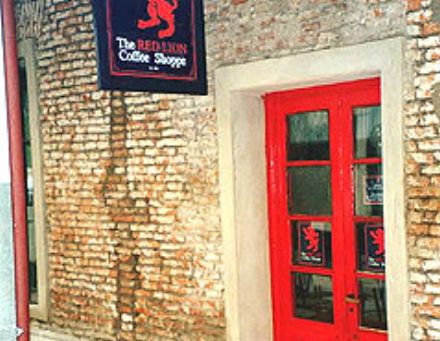
Graduation
In Which the Degree of Magister Artium is Conferred Upon the Author
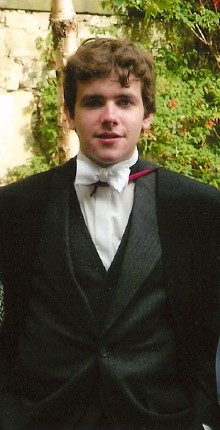 The reader is no doubt anxious to hear about the recent goings-on within the Royal Burgh of St Andrews, that ‘auld grey toon’, relating and pertaining to the awarding of a degree to yours truly in recompense for four arduous years of undergraduate study, and so I bring it upon myself to relate a chronicle of said events.
The reader is no doubt anxious to hear about the recent goings-on within the Royal Burgh of St Andrews, that ‘auld grey toon’, relating and pertaining to the awarding of a degree to yours truly in recompense for four arduous years of undergraduate study, and so I bring it upon myself to relate a chronicle of said events.
The Saturday preceding graduation week, I was sitting enjoying a cup of tea with young Miss Dempsey in the Common Room of Canmore on the Scores when I gazed out the window and chanced upon my own dear uncle, Col. Matthew Cusack himself, gazing back at me with surprise. I rushed outside to greet him and invited him in to Canmore to introduce him to Clare before continuing back outside to seek the remainder of my visiting relatives due to arrive. We found them all (bar my brother Airman Matthew Cusack, who would arrive a few days later) around the corner up Murray Park, and it was then that I was first introduced to my dear little nephew Finn, merely a few weeks after his happy arrival. My mother, father, sister, brother-in-law, uncle, aunt, and second uncle all accompanied the little one, whom I have placed under the protection of St. Marcellinus. We made our way to the surprisingly commodious house on the Scores which we rented for the duration of the week and settled down in our temporary abode. (more…)
Awaiting Pars Secunda
Since my university years have now come to their scheduled conclusion, there has naturally been much speculation in the learned societies and respectable journals as to what shall become of me. One of our Novanglian fellow-travellers has suggested I follow young Winston Churchill’s aim of legislative service, though I’d rather be a subaltern in the 4th Hussars! Colonel Cusack, meanwhile, has suggested the Executive Mansion rather than the House of Assembly. Alas, the future of young Cusack remains as yet shrouded by a misted veil of uncertainty through which not even old Tiresias can portend. My own particular desire is to be rolled around Bronxville in a wheelchair, flannel blanket covering my lap, with a cane to shake in fury at passing vagrants.
Previously: Whither Cusack?
Honours of Various Sorts
Sentenced to life…
The University of St Andrews Students Association has apparently decided to reward my tireless efforts towards the embetterment of my fellow St Andreans with Honorary Life Membership of that body. I find it rather nice and very amusing, not to mention ironic, being as a central part of said tireless efforts has been waging intellectual warfare against the Students Association. I asked those in the know (chiefly my former secretary, Miss Alexandra Jennings, who formerly held positions in the Association) and apparently I’ve been on the list to receive one since second year, except they’re only given to graduating magistrands (that’s fourth-years, ye laymen) so I had to wait until now for it. I assume it is in recognition for my foundation of the Mitre, the first quality student newspaper at the University of St Andrews in some many years. Alas, the Mitre was laid to rest owing to my dissertation work, but it just might be revived by the legendary Jon Burke and some of his crew next year. (Watch this space!). The ever-charming Miss Alexandra Harrod will also receive an Honorary Life Membership, so at least I’ll have someone to chat with at the ceremony next week. I wonder if I get to adoptd H.L.M as postnominals?
A degree
Speaking of postnominals, I’ve finally earned myself some. As of just a few days ago I am now Andrew K. B. Cusack, M.A. (Hons). The Universitas Doctorum Magistrorum et Scholarum Sancti Andreae apud Scotos has seen fit to award me with the title of Magister Artium, or to be more precise a Master of the Arts (Honours, Second Class, Division II). This degree is more commonly referred to as a 2:2, nicknamed a ‘Desmond’ after the former Archbishop of Cape Town, Desmond Tutu. I am very glad, even a little surprised, to be getting my degree on time in the allotted four years, but I must confess I am mildly disappointed with the 2:2. Evelyn Waugh was famously of the opinion that one should get either a First or a Fourth. Fourths have since been abolished on the grounds that they might hurt someone’s feelings, and thus Seconds became 2:1’s, Thirds became 2:2’s, and Fourths became Thirds. Firsts, naturally, remain Firsts, and chiefly go to two categories of persons: 1) Complete bores who do nothing but sit in the library, studying, revising, and doing lots of work, and 2) Interesting and rather clever people who say to themselves “Hmmm… think I’ll go for a first” and do. 2:1’s, then, have rather become the standard degree, awarded to most students. I, as stated, have been awarded the 2:2, which is the St Andrews equivalent of the Gentleman’s C. It shows you were either too busy with either your own individual research outwith the academic curriculum or you just couldn’t be bothered to waste your hours on academic work. I think I’m guilty on both counts. The Third, then, is the lowest of the low, but has a certain cachet about it for that. Certainly a number of stupid people get thirds, but then a number of clever folks do as well, and they have every right to wear it as a badge of honour. At any rate, I’m very happy to have my degree at all, and an M.A. to boot. Beats all those lousy BAs and BScs my camarades back home are receiving. My graduation exercises (a mere formality, which disgusting modernists like Nicholas Vincent neglect to attend) take place the Thursday of next week, and a large delegation of the Clan Cusack are hopping the pond for the event. Rather looking forward to it, actually.
The Fife Show

This past Saturday we went on a little expedition to the neighbouring town of Cupar for the annual Fife Show put on by the Fife Agricultural Association. It was an excellent day which provided much joviality. The venison hamburgers were especially enjoyed; I hadn’t had one since I was in Vermont years ago. And naturally there were plenty of animals; sheep, cattle, horses, dogs, but sadly no pigs. (more…)
Whither Cusack?
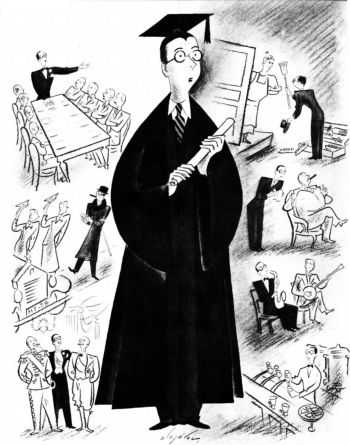
Today in Younger Hall I completed my very last university examination ever. Now all I need to do is graduate in the very same hall in June, and, of course, find some source of income. Thankfully, everyone’s been very helpful, realistic, and practical with career advice: they all see me as editor of the New Yorker. “Furry ’nuff,” I thought to myself, and dabbled into the realm of research by ‘logging on’ to that weekly’s internet presence wherein I discovered that the New Yorker not only already has an editor but it seems he has no intentions of relinquishing the position in the near future. Outrageous!
Well folks, what’s a lad to do?
Roma – Caput Mundi

Well I’ve finally got around to putting up my report of our pilgrimage to Rome in March, with a plethora of accompanying photographs. It was an amazing time; Easter excepted, it was the jewel in the crown of our penetential season. Read about it all here.
The Sad State of the Modern Newspaper
…and the heroism of an Anglo-Hungarian countess.
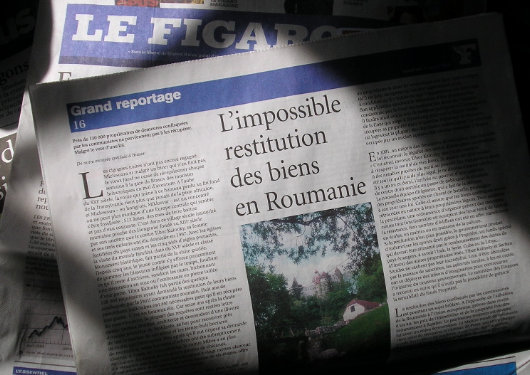
IT IS ONE OF THE more saddening facts of life that British newspapers have suffered an inexorable decline in the past few years. The great Times of London – once the most respected newspaper in the world – has been reduced to a boring mid-brow tabloid, the once-solid Scotsman idiotified and, again, tabloided, and of course the Daily Telegraph, which has gone from staunchly conservative (as in worldview) to merely Conservative (as in the tribe of Britons who prefer blue to red).
The Telegraph, like the Conservative party itself, doesn’t seem to know what it’s there for. It has at least remained a broadsheet; going tabloid would be a disaster and would probably be considered the last straw for all the die-hards for whom loyalty to one’s newspaper is a point of pride. And, to its credit, it finally seems to have realised the damage done by constant front-page photos of “Posh” and “Becks” and other “celebrity” partisans of the Anti-Culture, for they seem fewer and far between these days (as compared to a year or two ago, when they were frequent). The Telegraph‘s base are old folk who want a quality newspaper. They are loyal to the Tele and, despite its decline, would be too embarrassed to jump ship to the Guardian, which is written better but which nonetheless expones a nefarious ideology.
As for myself, the last straw came one morning in the Common Room of St. Salvator’s Hall when, flipping through the Telegraph, I reached the page which normally displays the Court Circular but found it missing, replaced by a curt statement advising that should I desire information about the activities of the Royal Family I should direct myself to http://www.royal.gov.uk. Outrageous! As it happens, this is not a permanent loss but rather an occasional one, as the editors at the Telegraph seem to decide whether or not to print the Court Circular each day on a whim. Fair enough, but I came to the realisation that the producers of the Telegraph are not aiming at me – the reasonably educated young man who seeks in his daily read a newspaper that is well-written, right-thinking, and properly presented – and so I have ceased to be a Telegraph regular.
What to read then? We have already dismissed the Times, the Scotsman, and the Guardian. The Daily Mail is always readable but arguably aimed at a different demographic; the Daily Mirror, bonkers; the Sun, no thank you!; the Financial Times is too boring, though the Weekend edition is actually worth buying most of the time; the Independent has a good layout for a tabloid, but is rather of a Lib-Dem persuasion; the Glasgow Herald is just rather dull and has only recently repented of its long-held anti-Catholicism. Not wanting to support the nefarious New York Times, enemy of Western civilization and the last word in liberal elitism, its wholly-owned subsidiary the International Herald-Tribune is ruled out. Which pretty much rules out every English language daily newspaper available in St Andrews.
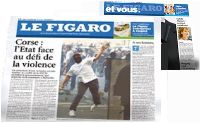 So, abandonné par ma langue, I have outsourced my daily read to the Continent (of all places!) and am now a partisan of Le Figaro. While by no means fluent in the language, I can comprehend written French with greater ability than I speak it. And while I still prefer the feel of a broadsheet, the Berliner size of Le Figaro has its advantages, being very easy to read in the confined space of my regular chair in the corner of the little coffee shop down the street. More importantly, I find it much more engaging mentally, which I put down to the fact that (not being a native or fluent French speaker) I am forced to read every word. Reading the Telegraph one unthinkingly only actually reads every third or so word; articles of particular interest excepted, naturally. The day’s Figaro usually arrives in the middle of the day or the afternoon, but I buy my paper in the morning so actually I’m usually reading the previous day’s Figaro. I don’t mind, it suits my current routine. (Mornings are for reading the newspaper in a coffee shop, afternoons are for reading books with a slow pint in the pub.)
So, abandonné par ma langue, I have outsourced my daily read to the Continent (of all places!) and am now a partisan of Le Figaro. While by no means fluent in the language, I can comprehend written French with greater ability than I speak it. And while I still prefer the feel of a broadsheet, the Berliner size of Le Figaro has its advantages, being very easy to read in the confined space of my regular chair in the corner of the little coffee shop down the street. More importantly, I find it much more engaging mentally, which I put down to the fact that (not being a native or fluent French speaker) I am forced to read every word. Reading the Telegraph one unthinkingly only actually reads every third or so word; articles of particular interest excepted, naturally. The day’s Figaro usually arrives in the middle of the day or the afternoon, but I buy my paper in the morning so actually I’m usually reading the previous day’s Figaro. I don’t mind, it suits my current routine. (Mornings are for reading the newspaper in a coffee shop, afternoons are for reading books with a slow pint in the pub.)
The chief deficit of reading a French newspaper is that naturally the news is oriented towards France, and thus I don’t get the usual transatlantic focus of the British papers (which can be an advantage as well as a deficit, I’ll concede). Nonetheless, it does happen to have articles of interest to any trad.
A few weeks ago, Le Figaro reported on the restitution of Romanian castles to their original, pre-Communist owners (‘L’impossible restitution des biens en Roumanie’, Le Figaro, 21 April 2006). The New York Sun rather amusingly and provincially headlined the story “Westchester Man To Take Possesion of Dracula’s Castle” — the New York Post characteristically used the headline “VLAD TIDINGS“. (FTD also reported on the restitution of Bran). When I wrote my previous post on the subject I was under the impression that Bran was one of the castles which would be restituted and then purchased back by the Romanian government, but most sources imply that this is not the case and Dominic von Habsburg (of North Salem, New York) will actually take possesion of the castle, I’m glad to hear.
This morning, then, I read in Le Figaro of the controversy surrounding a red star which remains on a Soviet war memorial in a small town in Hungary, a country which has banned all Communist and Nazi emblems (‘Hongrie: Le pasteur, la comtesse et l’étoile rouge’, Le Figaro, 6 May 2006). The local Protestant minister has been fighting to replace the red star, and has found an ally in Countess Jeanne-Marie Wenckheim-Dickens. The Countess, aged 70 and a descendant of Charles Dickens, returned to Hungary a few years ago after her husband died. The family had fled the country in 1944 just escaping the conquering Red Army. “I return home,” the Countess says (‘with a delicious British accent’, Le Figaro reports), “and what do I find? My castle transformed into an elementary school with, right in front of the gate, a red star! To me, this star is the Antichrist.”
The Countess funded the restoration of her former castle, now a school, and obtained permission from the town to live in the old presbytery, an ancillary building of the old castle. But when, in 2004, she proposed to mark the accession of Hungary to the European Union by replacing the red star on the monument with a European flag, the ex-Communists in the town hall told her she “should not be afraid of the red star, but of the Cross!” With fighting spirit, “I placed a large cross on my entryway,” the Countess says, “then I painted it gold so that the Mayor, whose window is opposite, can see it all the better.”
“Crosses? She can build a hundred of them!” the Mayor said. “It doesn’t disturb me!” But in return the Mayor had a house on what was the domain of the Wenckheim family renovated for the use of unemployed local gypsies. “It was clearly to annoy me,” the Countess said. “They thought the gypsies were going to make the area around the nearby church, built by my grandfather, filthy. But not at all! They respect the place, and I, I love their music very much.” The Countess also gives weekly catechism lessons to the local gypsies. In her window, she displays a letter to the people of the town inviting them to vote for the conservative Fidesz party. “In December,” the Countess continues, “before Christmas, I add little angels and holy pictures; they don’t like that much across the way, since they’re aimed at the town hall. Because I, too, have a star: but is the star of the Shepherd”.
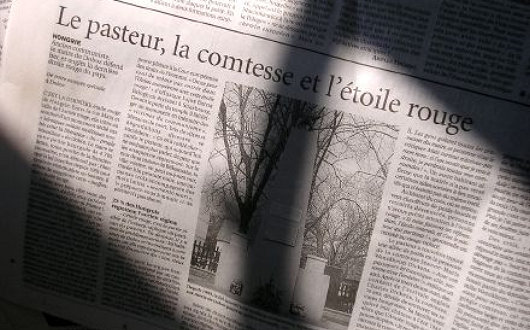
A Mighty Headache
Ask not for whom the bell tolls, it tolls for thee…
As I sat in bed this morning, hearing the bells of St. Salvator’s summoning the studentry from their cozy chambers to the hebdomadal chapel service, the fifteen minutes of tolling summoned naught but two thoughts from the deep recesses of my brain: doom and misery. The reader will forgive this rather grim introduction, but grim was precisely the feeling in the ascendant this morning. I shall continue by retreating to the beginning.
The merriment began at about one o’clock in the afternoon in the Central bar, as have many a session of merriment and good laddery. My good friend Chris C. was visiting the Royal Burgh for the weekend and we decided to head to the Central for a smooth, satisfying pint of John Smith’s, which is the preferred tipple for joint C./Cusack operations. Making our way to that public house, we chanced upon none other than Manuel Pantelias Garces, the little fellah who packs a tremendous punch, and invited him to join in our imbibing of Yorkshire ale.
And imbibe we did. We had one pint of John Smith’s, followed by another, then another, and then another until I swept over to Step Rock Cottage to be fashionably late for Jon and Abby’s engagement party. There, for some unknown reason, I declined copious amounts of Louis Jadot instead deciding to drink down a mighty torrent of Bucks Fizz. In a jocular and celebratory mood, I decided to purchase a ticket to tommorrow’s charity polo tournament off Richard Holtum, and discussed various things with Adrian and young Miss Tori Truett who had popped up from London to grace us with her beauty and wit. (more…)
Old Speckled Hen
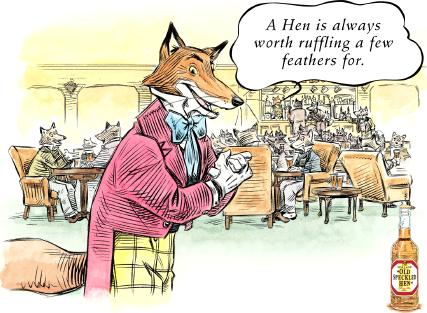
Spring has come late to Fife this year, but I do think we’re all the better for it. One appreciates so much more these spriteful spring days after a longer dark season, though in all honesty I already partly miss the many snowy days we enjoyed in St Andrews this winter. How splendid it is to warm oneself by the fire on a cold winter’s day, with a cup of coffee or a pint of ale and some Washington Irving to read. None of that today, however!
Quite a decent day, really. The eleven o’clock Mass saw a good friend received into the Church, followed by her Confirmation along with another friend of mine. After the post-Mass tea and coffee, myself, young McMorrin, Tom Howard, Adrian, Miss Brennan, Michelle, and Miss Dempsey got sandwiches from Cherries and enjoyed the sun-soaked ruins of the Cathedral cloister. I had a delicious honey mustard chicken and stuffing brown-bread baguette, splendidly washed down with a bottle of Old Speckled Hen. (more…)
A Happy Easter To You All!
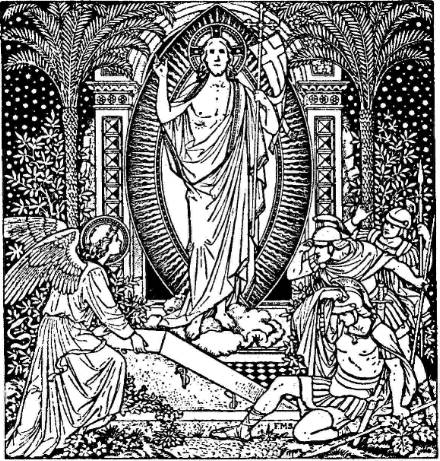
A very pleasant Easter here in St Andrews. The vigil last night was rather nice, and practically by accident. We all got roped into doing some of the readings, much to our own collective chagrins since we’re not real participatory type when it comes to liturgy. But it ended up being appropriate since this is, for a number of us, our last Easter in St Andrews. Alex Harrod did the first reading, Matt Gorrie the second, Amanda ‘Commanda’ Brennan the third, yours truly the fourth, Abby the fifth, Jon Burke the sixth, and Clare the seventh reading. Naturally we all went to the Russell afterwards for a pint, and it was generally decided that Burke read the best.
Then this morning to Step Rock Cottage for a classic fry-up. Toast, sausages, pancakes, and potato waffles, liberally buttered and doused in maple syrup. An absolute delight and perfect for Easter morning. We made gluttons of ourselves while browsing the Sunday papers, then watched the Urbi et Orbi message and blessing (for which, Cardinal Castrillon Hoyos informed us, we received an indulgence!), followed by Charlton Heston and Rex Harrison in The Agony and the Ecstasy. Tonight, dinner at Canmore, hopefully followed by the penultimate installment of The Scarlet Pimpernel in our weekly counter-revolutionary film series at the Chaplaincy. Vive le Roi!
Speaking of which, in addition to being the feast of the Resurrection, this day is also blessed with the anniversaries of the birth of two of Europe’s remaining sovereigns: Pope Benedict XVI himself and dear Margrethe II, the Queen of Denmark. We hope and pray they both have many more returns on the day, in happiness, peace, and prosperity.
I am an Uncle
Hot dang, what a break! I am now safely entrenched in my humble little chamber in St. Salvator’s Hall, North Street, Royal Burgh of St. Andrews, Kingdom of Fife, Scotland, United Kingdom of Great Britain and Northern Ireland, God’s Own English-Speaking World, the Planet Earth, the Milky Way, the Universe, the Mind of God. The first week of my two-week vacation, you will no doubt recall, was spent in the Eternal City: Roma, Caput Mundi. I had not been to Europe in six years, I believe, and since that time the entire continent has adopted Monopoly Money as the official currency. Johnny Foreigner, what will he do next! Despite being in Europe, it is Rome after all, and thus both the birthplace and font of Western Civilization. A suitably humbling experience. Brilliant.
Then an exceedingly brief foray to Trinity College Dublin in our neighbourly Republic to have a few pints and some damn good laughs with one of the leaders of Youth Defence, Ireland’s main pro-life group, (I would give his name but it’s Gaelic and thus impossible to spell) and to hear an update on the general state of things large and small in Éire. Despite being civilised English-speakers over there, they seem to have adopted the Monopoly Money as well. Odd.
Then to Somerset (or ‘Zomerzet’ as the endearing locals call it) to the great Basilica and Monastery of Saint Gregory the Great, founded at Douai in France, removed to Acton Burnell in England to escape the nefarious and ungodly French Revolution, and currently located at a place most commonly called Downside. Our good friends Robert and Maria O’Brien upheld their usual high standard of entertainment. A week in the English countryside is a most enjoyable thing after having spent week on the Continent, perhaps even necessary. Last night, Jon and Abby joined us since they were in nearby Bristol and we all got drunk as lords. To top it all off, Pop called heralding the birth of Master Finn Daniel Larson, thus elevating me to Unclehood. Well, as you can imagine, we had even more to drink after hearing that news. Splendid!
Well friends, you can appreciate the need for a little rest and relaxation, even though I just spent a week resting and relaxing at Downside, so I will bid you adieu for now. You can expect a full report on our amazing Roman expedition within the next few days.
The Rectorial Festivities
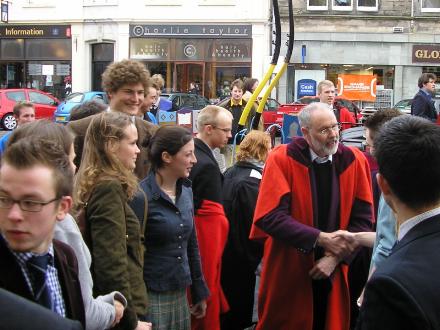
How one enjoys the traditional and ceremonial side of university life! Having duly elected Simon Pepper OBE as the new Lord Rector of the Universitas Sancti Andreae, the usual rigamarole of festivities and rites recently took place. The first is the Rectorial Drag, in which the Blues of the University drag the new Lord Rector around the town in a carriage. Along the way he makes various stops, mostly at public houses, in which a number of student groups and the like present him with gifts and drinks. We in the Boat Club arranged to meet the Lord Rector at the Central bar in Market Street. Above (and below), having alighted from his carriage, the Lord Rector greets a number of students, among them Felix Lobkowicz, the recently-elected President of the Boat Club, and Chris Kololian, the outgoing president. (more…)
Thoughts of Late

The Hill of Crosses in Lithuania. Over the years, the faithful left crosses on this hill to praise God and signify their appreciation for the many graces and mercies bestowed by Him. During the Soviet occupation of Lithuania, the hill was twice demolished and cleared by the Communists. Each time it was reconstructed by the people, and on its third appearance the Soviets finally allowed it to stay. Despite strong evidence of Christian faith such as this, the University of St Andrews ‘Christian Union’ claims that Lithuania is a heathen country, ‘with only 35 Christians’.
 During my presence at St Andrews over four years, it has snowed on a few occasions, though never stuck for more than a few minutes. I was much pleased, then, to awake on March 2 and spy through my windows (I never draw the curtains, as I enjoy the early morning sun) a blissful wintry utopia. The auld gray toon had been transformed into a veritable snow-globe, with snowflakes shifting back and forth with the wind as gravity drew them nearer their earthly home. Delightfully, this snow lasted, affording thousands of students myriad opportunities for heavenly mischief and giving me an excuse to put on my trusty Sportos. (Trusty Sportos seen at right).
During my presence at St Andrews over four years, it has snowed on a few occasions, though never stuck for more than a few minutes. I was much pleased, then, to awake on March 2 and spy through my windows (I never draw the curtains, as I enjoy the early morning sun) a blissful wintry utopia. The auld gray toon had been transformed into a veritable snow-globe, with snowflakes shifting back and forth with the wind as gravity drew them nearer their earthly home. Delightfully, this snow lasted, affording thousands of students myriad opportunities for heavenly mischief and giving me an excuse to put on my trusty Sportos. (Trusty Sportos seen at right).
But, woe of woes, I had a presentation to give that afternoon on the mundane and irascibly dull subject of the historiography of Indian/Settler relations in colonial America. I, and about four or five others out of a class of nearly twenty, duly arrived in the Old Library of St. John’s House at the appointed hour. We, the few, pondered where everyone else was. Had they autonomously declared a holiday? Risky business, considering this was a tutorial, and thus required, unlike lectures, of which I likely attended less than a third of my due during the past four years. A kindly secretary came in to inform us that Dr. Hart had cancelled the class and thus we were all free to frolic in the abundant snow to our little hearts’ content. Naturally, I just went to Rosary.
Speaking of Rosary, one day the week previous the post-Rosary revelry nearly drank the town dry. Well, perhaps I ought to give some background to our bliss. The Rosary is said every day Monday through Friday in St. James Church at 1:30 after which we all process across the street to the Common Room in Canmore. One or two of the girls, or Adrian if the girls are absent, make a round of tea for the merry band of Marian devotees. Well, on this frigid day in Scotland (a land of poorly-heated buildings, if one’s lucky enough to have heating on at all), we all huddled by the electric fire in our chairs, surmounted by a large communal blanket. Tom brought a bottle of port, of which we all partook, before I then excused myself to go off and do some equally time-wasting task. Well apparently the Rosary crew finished off that bottle of port, and then went and purchased another one! What’s more, the rapacious dipsomaniacs, once they had finished that bottle of port they emptied the reserve bottle of whiskey I keep hidden behind the German dictionaries in the library upstairs. Disgraceful! I have decided not to replenish the secret reserve, since, to put it in the vernacular parlance, is nae secret anaemoor!
Of course it’s my own fault for leaving it in the Chaplaincy. Should I have hidden it in the chaplaincy of the very friendly heretics over in St. Mary’s Place across from the Students Union, it would have remained unmolested. The worse that could happen would be the Christian Union forming a prayer circle around it and praying for the Good Lord to make it go away. (We Catholics already posess the knowledge on making drink disappear, and how!).
Ah, the ‘Christian Union’! Not in the entire English-speaking world, I daresay, does there exist a more delusional body of people. Everything about them is either hilariously funny or pitably sad, beginning with the irony of their very name. The Christian Union, as it styles itself, actually bans most Christians from joining. Those who wish to sign up (poor fools!) must be willing to sign a statement of faith extolling the tenets of the Evangelical Protestant religion. Thus Catholics, Orthodox, and even most Anglicans are not allowed to join. I have sometimes posited contacting whichever bureau of Britain’s behemoth government is responsible for truth in advertising and trying to get them to get the Christian Union to change their name. ‘Evangelical Society’ would be the most appropriate; while ‘Society of Over-Emotional Self-Deluding Followers of Feel-Good Teddy-Bear Christianity’ might be more accurate we must give some allowance for PR these days.
One of the latest projects of the Christian Union is to work for the ‘Christianization’ of Lithuania, “since there are only 35 Christians in the entire country”. It has apparently escaped the C.U. that Lithuania was Christianised ten centuries ago and has remained a vibrantly Christian country, even through decades of Soviet persecution. But perhaps we should leave them in their self-delusion, if only for the hilarity it provides for the rest of us. One can almost imagine them being given demographic information about the population of heaven, with thousands upon thousands of the patriarchs and prophets of the Old Testament, the apostles, the Church fathers, the martyrs, confessors, priests, nuns, and all the legions of holy souls: “But there are only 35 Christians!”

St Andrews Snowfall
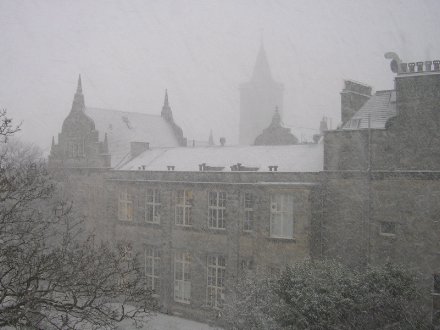
In an act of worship of the goddess Effeciency, the U.K. Government, or the Meteorological Office thereof, declared March 1 to be the beginning of Spring rather than the traditional, astronomical, and accurate Vernal Equinox (March 20). True to form, Mother Nature (a proud woman), decided that, in the interests of putting the upstarts in their proper place, she would open the heavens and thus a bountiful snowfall was produced the ver next day. I took a few snaps from my little chamber in St. Salvator’s Hall for your enjoyment. (more…)
Search
Instagram: @andcusack
Click here for my Instagram photos.Most Recent Posts
- Faithful Shepherd of the Falklands April 8, 2025
- Articles of Note: 8 April 2025 April 8, 2025
- Proportionality Destroys Representation April 8, 2025
- Sag Harbor Cinema March 26, 2025
- Teutonic Takeover March 10, 2025
Most Recent Comments
Book Wishlist
Monthly Archives
Categories


